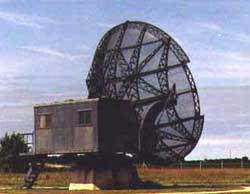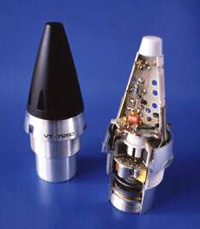Radar during World War II: Difference between revisions
No edit summary |
No edit summary |
||
| Line 9: | Line 9: | ||
<br> | <br> | ||
The threat of bombing revived interest in a technology that had been invented several decades earlier but not developed—radar. Radar works by sending out radio waves and detecting any reflections from distant objects. In 1904 the German Christian Hülsmeyer patented a means to do this, but the invention attracted very little interest. But in the late 1930s the threat of air attack stimulated work on this technology, and research groups in at least eight countries—France, Germany, Italy, Japan, Netherlands, the Soviet Union, the United Kingdom, and the United States—independently developed radar. Even before the outbreak of war Britain had built an air-defense radar system called [[Chain Home|Chain Home]]. In the United States, researchers at MIT's Rad Lab and the U.S Naval Research Laboratory also hurried to develop radar. | The threat of bombing revived interest in a technology that had been invented several decades earlier but not developed—radar. Radar works by sending out [[Radio Waves|radio waves]] and detecting any reflections from distant objects. In 1904 the German Christian Hülsmeyer patented a means to do this, but the invention attracted very little interest. But in the late 1930s the threat of air attack stimulated work on this technology, and research groups in at least eight countries—France, Germany, Italy, Japan, Netherlands, the Soviet Union, the United Kingdom, and the United States—independently developed radar. Even before the outbreak of war Britain had built an air-defense radar system called [[Chain Home|Chain Home]]. In the United States, researchers at MIT's Rad Lab and the U.S Naval Research Laboratory also hurried to develop radar. | ||
<br> | <br> | ||
Revision as of 19:00, 28 January 2009
Radar during World War II
It has been said that radar won the war for the Allies in World War II. While that’s an overstatement, it is true that radar had a huge impact on how World War II was fought on both sides. Radar is, in essence, a very basic way of obtaining information. That very simplicity makes it highly adaptable—during the war scientists and engineers found dozens of ways of using it.
During World War I (1914-1918) airplanes played a relatively small role, being used mainly for reconnaissance. But as airplanes increased in size, range, and speed in the 1920s, it became clear that they would become major weapons in future wars. Bombing was the major concern. Airplanes might carry enormously destructive bombs, and there was little to prevent enemy aircraft from reaching a nation’s cities. The words of British Prime Minister Stanley Baldwin, spoken in 1932, were well known: “the bomber will always get through.”
The threat of bombing revived interest in a technology that had been invented several decades earlier but not developed—radar. Radar works by sending out radio waves and detecting any reflections from distant objects. In 1904 the German Christian Hülsmeyer patented a means to do this, but the invention attracted very little interest. But in the late 1930s the threat of air attack stimulated work on this technology, and research groups in at least eight countries—France, Germany, Italy, Japan, Netherlands, the Soviet Union, the United Kingdom, and the United States—independently developed radar. Even before the outbreak of war Britain had built an air-defense radar system called Chain Home. In the United States, researchers at MIT's Rad Lab and the U.S Naval Research Laboratory also hurried to develop radar.
Radar, which is essentially “seeing” with radio waves, found dozens of other uses in the war. It was used to aim searchlights, then to aim anti-aircraft guns. It was put on ships, where it was used to navigate at night and through fog, to locate enemy ships and aircraft, and to direct gunfire. It was put into airplanes, where it might be used to locate hostile aircraft or ships, or to navigate the aircraft, or to find bombing targets. Radar could be used to locate enemy artillery and even buried mines. Military meteorologists used radar to track storms.
German engineers also developed radars during World War II. Perhaps the most important of these was the “Würzburg” type shown here at an installation in Douvre, France (then German-occupied France). It’s 8-meter wide dish antenna was part of a system used to detect incoming aircraft.
A remarkable use of radar during World War II was the proximity fuze. The idea was simple, but seemingly impossible: put a tiny radar set on each artillery shell, and have the radar set trigger the detonation of the shell when it was close to its target. Smaller and more rugged tubes and appropriate control systems were developed, and the proximity fuze moved rapidly from experimental device to use in practical weapons. By the end of the war some 22 million had been produced, and they became very important in artillery, particularly anti-aircraft artillery. Proximity fuses, like the modern one at right, remain in use today. Courtesy: Aselsan Electronic Industries, Inc.
One of the most important radar advances of the war was the movement to higher frequency (thus shorter) radio waves especially into the region of the electromagnetic spectrum called microwave. The shorter wavelengths were easier to focus into narrow beams. This meant that a distant object would reflect more energy back. Even more importantly, higher frequencies gave greater resolution. Directing anti-aircraft and long-range naval guns entirely by radar required microwave frequencies, as did displaying the topography below an aircraft when radar was used for navigation. The most important technical breakthrough in the move to higher frequency radar was the invention of the cavity magnetron. It was invented in 1940 by two British researchers, J.T. Randall and Henry Boot, at the University of Birmingham.

